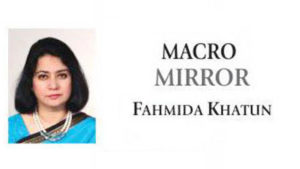Published in The Daily Star on Monday, 6 March 2017
MACRO MIRROR
 Bangladeshi women are participating in the labour force at an increasing rate. Compared to four percent in 1974, female participation in the labour force has increased to 33.9 percent in 2015, according to the Bangladesh Bureau of Statistics. This change is much faster than the growth of male labour force participation which increased to 82.5 percent in 2015 from 80.4 percent in 1974. Not only in the export oriented readymade garments sector, but in many non-traditional and emerging sectors, such as hotel and restaurants, transport, real estate services, telecommunications, and banking and insurance sectors, women’s participation is increasing. This is due to the fact that with increased access to higher education, the prospect for getting into high valued job market has expanded for women in Bangladesh. However, as a late comer to such services, the number of female participants is still low. Moreover, the progress has not been uniform in all sectors. There is also discordance within the sector. Not many women are seen in managerial and senior positions of organisations even after the growth. Under-representation of women in decision making jobs is due to a mix of economic, social and cultural situations.
Bangladeshi women are participating in the labour force at an increasing rate. Compared to four percent in 1974, female participation in the labour force has increased to 33.9 percent in 2015, according to the Bangladesh Bureau of Statistics. This change is much faster than the growth of male labour force participation which increased to 82.5 percent in 2015 from 80.4 percent in 1974. Not only in the export oriented readymade garments sector, but in many non-traditional and emerging sectors, such as hotel and restaurants, transport, real estate services, telecommunications, and banking and insurance sectors, women’s participation is increasing. This is due to the fact that with increased access to higher education, the prospect for getting into high valued job market has expanded for women in Bangladesh. However, as a late comer to such services, the number of female participants is still low. Moreover, the progress has not been uniform in all sectors. There is also discordance within the sector. Not many women are seen in managerial and senior positions of organisations even after the growth. Under-representation of women in decision making jobs is due to a mix of economic, social and cultural situations.
It is commonly heard that there are not many women who are capable of being at the decision making level at offices. This is partially true. The number of educated women has increased over time, but the rate of highly educated women is not as large yet when compared to men. Statistics show that women’s educational attainment at the secondary level is higher than men. However, it starts to decline afterwards. Only 2 percent female labour force have tertiary level education. The unemployment rate is much higher for women: 7.01 percent of women are unemployed while 3.13 percent of men are unemployed. Women are engaged in low paid jobs compared to men. According to official statistics, though on average women earn about 94 percent of what men earn, it varies across sectors. The low share of women’s income compared to men on average is partly due to women’s involvement in the informal sector to a greater extent. The informal sector comprises the major share of female employment which is about 92.6 percent.

Social aspects play another important role. Because of their reproductive role, many women are forced to choose between motherhood and their career. A large number of young university graduates enter the job market with a lot of enthusiasm. But that starts to fade within a few years as they are expected to expand their families. This mid-way exodus of female executives reduces the number of capable women in senior positions. In many advanced countries, some women have abandoned motherhood, even marriage, to take part in the highly competitive job market. Even then, the rate of women in decision making jobs is not that high. There is the glass ceiling; women have to be twice as good as men to get there. The predicaments which stand in the way for women to take a leading role are more or less universal. But in developing countries, this is probably felt more strongly.
Another predicament is the lack of opportunity for women to gain wisdom and understanding from those who have already been successful in the executive room. There are a number of successful women out there, but not as many as to match the requirement, who can guide and advise other aspirants. The concept of a mentor in case of women executives is not that common yet. While a male co-worker can easily discuss and share professional issues and receive guidance from a senior, for female workers this is not that easy.
Therefore, if we want to see more women in top executive roles, the creation of a level playing field and acceptance of the view that women are equally capable to perform the job are the first steps. Assumptions, biases and prejudices about women and leadership work against women’s advancement. Employer’s assumptions that women would not be able to accept responsibility, or take on a new role are barriers to bring out their full potential. They should be assigned tasks in the same way men are to demonstrate their abilities and talents as well as their potential for bigger roles. Diversity is not just limited to recruitment. They have to be provided with opportunities.
Unfortunately, the culture of valuing female ideas is absent not only in families, but in workplaces too. Often the ideas of female colleagues are undervalued. In meetings, the opinion of a female colleague is not heard until a man says the same thing – may be in a louder and stronger voice. This undermines the confidence of female staff. Hesitation, doubts and lack of assertion stand in the way of their progress, not lack of ideas or the willingness to work.
The work and family balance needs of women with children is a critical issue. Wherever possible, through flexible working arrangements, talented women can be retained. Female issues are mostly left with female colleagues. Men also need mentoring on gender sensitivity so that they can learn what they need to do to enhance opportunities for the qualified women in their organisations.
Women tend to believe that you advance your career and attain leadership positions by working hard. They take on extra work to prove their commitment. They strive to excel by gaining additional qualifications. Women outperform men not only in schools and universities. Then why not do the same at their work place too? This is of course a structural problem, but this can be overcome through the right policies, a supportive environment and above all, an appropriate attitude at workplaces.
The writer is the Executive Director at the Centre for Policy Dialogue.



